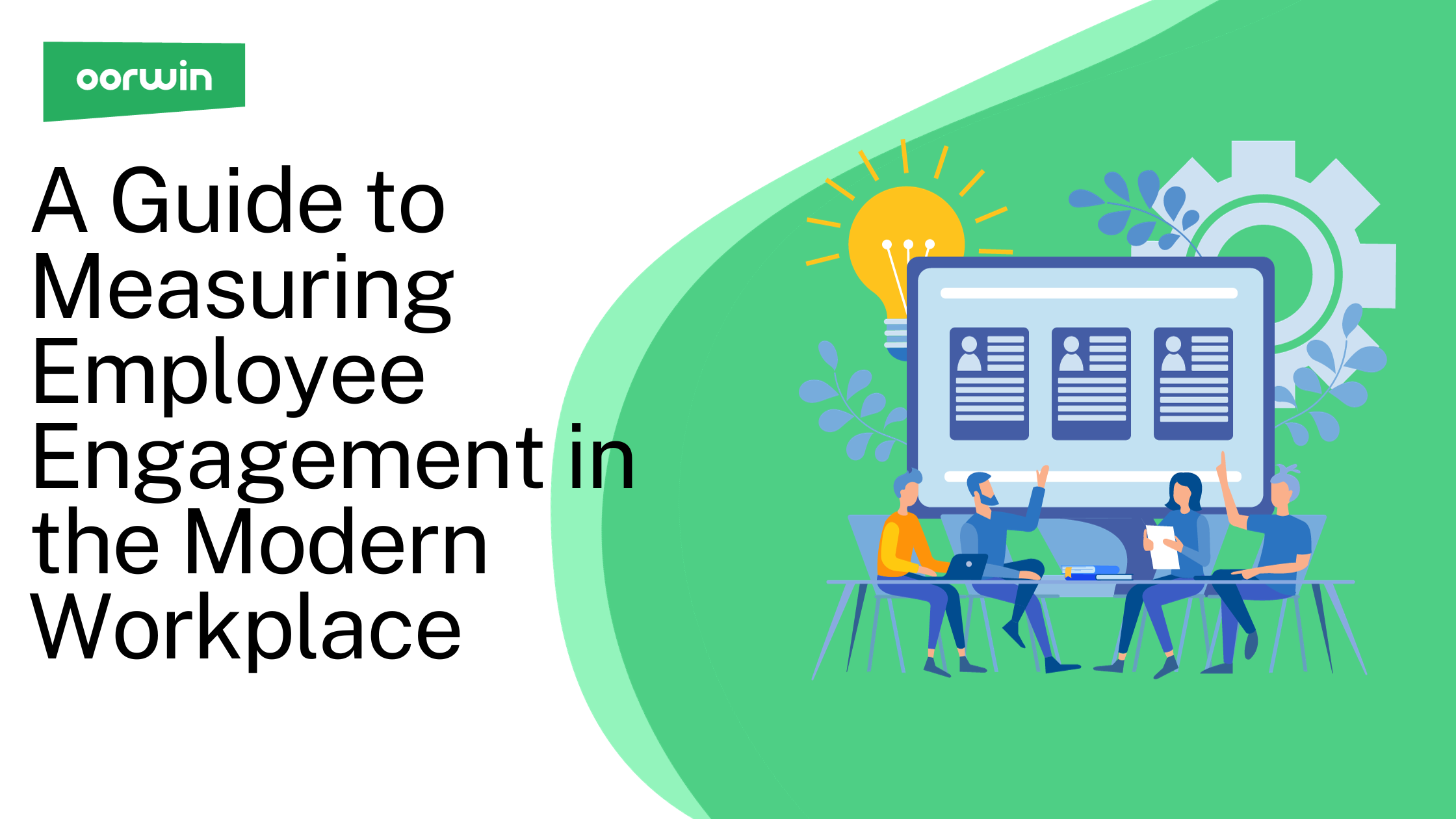A Guide to Measuring Employee Engagement in the Modern Workplace
Oorwin
3min read / 29 Dec 2023

Related Articles
How To Measure Employee Engagement Effectively
Measuring employee engagement is crucial for businesses to foster a productive and satisfied workforce. Understanding and improving employee engagement can lead to higher job satisfaction, increased productivity, and better overall performance in today’s competitive environment. This guide will delve into the importance of measuring engagement, key metrics to focus on, factors influencing employee engagement, methods for practical measurement, and actionable steps to take post-measurement.
Why should you measure engagement?
Assessing employee engagement is crucial for discovering areas needing enhancement, elevating job satisfaction, and keeping valuable employees. This measurement helps in recognizing the factors that drive or hinder engagement. Engaged employees typically demonstrate higher productivity, contributing significantly to the company’s profitability and overall success, making this a key aspect of organizational health.
Key Metrics for Measuring Employee Engagement
Measuring employee engagement effectively involves tracking several key metrics that reflect the health and vitality of your workforce.
Employee Turnover and Retention Rates
Analyzing employee turnover and retention rates is a powerful tool for gauging engagement. High turnover often signals issues in engagement, whereas robust retention suggests a thriving work environment. These metrics are key indicators of job satisfaction and organizational loyalty, offering insights into what motivates employees to stay and the factors that might lead them to leave. Understanding these dynamics is essential for maintaining a supportive, engaging workplace that attracts and retains talent.
Absenteeism and Employee Burnout
Monitoring absenteeism and signs of employee burnout is crucial for identifying potential disengagement. These issues often refer to deeper problems in workplace culture or management practices. By paying close attention to these red flags, organizations can pinpoint and address the root causes, paving the way for a more supportive and healthy work environment. This proactive approach is key to maintaining employee well-being and preventing long-term disengagement.
Wellness Days and Overworking Indicators
Keeping track of wellness days used and indicators of overworking is essential in evaluating employee work-life balance and overall well-being. These metrics shed light on whether employees are experiencing stress or feeling undervalued, both of which can substantially impact their engagement and productivity. Regular assessment of these factors is key to ensuring that employees are well-rested, promoting a healthy, balanced, and supportive work environment that nurtures employee satisfaction and engagement.
Online Workplace Ratings and Employee Feedback
Online workplace ratings and employee feedback from various platforms offer crucial insights into your organization’s operational strengths and areas needing improvement. This mix of formal and informal feedback serves as a direct gauge of employee engagement and satisfaction. Actively monitoring and responding to these insights helps understand employee perspectives, enhance the workplace environment, and ultimately boost overall engagement and satisfaction levels within the organization.
Customer Reviews as Indicators of Engagement
Customer reviews are a unique lens through which to view employee engagement. Positive feedback often correlates with high employee satisfaction, as engaged employees deliver exceptional customer service. Regularly examining these reviews can provide valuable insights into the external effects of internal engagement levels. This perspective is essential for understanding the broader impact of employee morale and commitment on customer experiences and the business’s overall reputation.
Employee Net Promoter Score (eNPS)
The Employee Net Promoter Score (eNPS) is a pivotal metric gauges the likelihood of employees recommending their workplace to friends and family. It clearly indicates employee satisfaction and loyalty, providing a snapshot of the overall organizational engagement. A high eNPS is a solid testament to a positive and supportive work environment, reflecting the success of employee engagement strategies and the company’s commitment to fostering a workplace that employees are proud to endorse.
Key Factors in Employee Engagement
Various factors influence employee engagement, each playing a critical role in shaping the employee experience and their level of commitment to the organization.
Feeling Proud of the Company
Employees who feel a deep sense of pride in their company typically show higher levels of engagement. This pride originates from the organization’s achievements, core values, and positive societal impact. When employees resonate with these aspects, they feel strongly connected to their workplace, driving their motivation and commitment. This emotional investment in the company’s ethos and success is a significant driver of employee engagement and loyalty.
Trusting Leaders and Teammates
Trust in leadership and among team members is a cornerstone of a positive and productive work environment. When employees trust their leaders and colleagues, it nurtures a culture of open communication and collaboration. This trust is crucial for fostering a sense of security and belonging, essential for strong employee engagement. A workplace where trust is prevalent tends to have a more cohesive and committed workforce, leading to higher performance and job satisfaction.
Opportunities to Grow in the Job
Providing career growth and development opportunities is a key factor in driving employee engagement. Employees who perceive clear prospects for personal and professional advancement within their organization are more motivated and engaged. This commitment stems from the belief that the company values its growth and invests in its future. Organizations that prioritize employee development create a culture of continuous learning, which can significantly enhance employee satisfaction and loyalty.
Clear Communication and Handling Changes
Effective communication, particularly during periods of change, plays a vital role in maintaining employee engagement. Transparent and open communication from management helps employees feel valued and informed. Involving employees in decision-making processes builds a sense of ownership and trust. Organizations that communicate effectively, especially in times of uncertainty or transition, are more likely to have engaged and committed employees who are adaptable and resilient to changes in the workplace.
Feeling Secure and Optimistic About Work
Job security and a positive outlook on the company’s future are essential for fostering employee engagement. Employees who feel secure and optimistic about the company’s direction are likely to be engaged and invested in their work. This sense of security and positivity enhances job satisfaction and encourages employees to contribute actively to the company’s success. An environment that promotes stability and a hopeful future can significantly boost employee morale and loyalty.
Being Recognized for Hard Work
Recognition of hard work and achievements plays a significant role in boosting employee morale and engagement. Regular acknowledgment and appreciation for their efforts contribute to employees’ sense of worth and belonging within the organization. This recognition can come in various forms, from verbal praise to formal awards, and is vital for enhancing job satisfaction. Employees who feel recognized are more motivated, often leading to increased productivity and loyalty to the company.
Balancing Work and Personal Life
Maintaining a healthy balance between work and personal life is critical for employee engagement. Organizations that respect and support their employees’ need for balance tend to have higher employee satisfaction and commitment levels. This support can manifest in flexible working arrangements, understanding personal commitments, and promoting a culture that values personal time. Such an approach to work-life balance is essential for preventing burnout and ensuring employees remain motivated, productive, and engaged in their professional roles.
Methods for Regular and Effective Measurement
Regularly measuring employee engagement is key to understanding and improving it. Several methods can be employed for consistent and effective measurement.
Utilizing Pulse Surveys for Immediate Feedback
Pulse surveys are an efficient tool for gathering immediate and frequent employee feedback. These short, regular surveys enable organizations to quickly gauge employee sentiment, providing a snapshot of engagement at any given time. The rapid feedback allows for prompt identification of issues and swift adjustments to engagement strategies. Pulse surveys are invaluable for maintaining a real-time pulse on employee morale and satisfaction, facilitating proactive management, and fostering a responsive workplace culture.
One-on-One Meetings
One-on-one meetings are crucial for deeply understanding individual employee experiences and concerns. These personal interactions allow for detailed discussions, offering insights that might not surface in group settings or formal surveys. Such meetings enable managers to connect with employees personally, building trust and open communication. The insights gained from these meetings contribute significantly to a comprehensive view of engagement, allowing for tailored strategies that address individual needs within the organization.
Small Group Discussions for Team Insights
Small group discussions are instrumental in uncovering team dynamics and collective experiences, shedding light on how groups function within the organization. These discussions encourage open dialogue among team members, revealing insights into team morale, collaboration, and challenges. The information gathered from these interactions provides valuable context to broader engagement trends and helps identify areas for team-level improvements. Facilitating such discussions promotes a sense of community and shared purpose, enhancing team cohesion and overall engagement.
Stay Interviews: Understanding Long-Term Engagement
Stay interviews are a proactive approach to understanding why employees remain with a company. These interviews delve into the factors that contribute to long-term engagement and commitment. Stay interviews provide critical insights into the elements that foster loyalty and satisfaction by exploring what employees value in their roles and the organization. This understanding is essential for developing strategies that enhance employee retention and ensure a supportive environment that encourages long-term commitment.
Exit Interviews: Gleaning Insights from Departures
Exit interviews offer a unique opportunity to gain valuable insights from departing employees. These interviews uncover reasons behind an employee’s decision to leave and can reveal areas where the organization may need improvement. The feedback obtained is often candid and insightful, providing a perspective that current employees might not express. Utilizing this feedback, organizations can identify trends, address systemic issues, and make informed adjustments to improve the workplace for remaining and future employees.
Actionable Steps Post-Engagement Measurement
After measuring employee engagement, taking actionable steps based on the insights gained to enhance engagement and address any identified issues is crucial.
Analyzing Employee Engagement Results
A thorough analysis of engagement data is crucial for spotting trends and pinpointing areas needing enhancement. This process informs strategic decisions, aiming to elevate employee satisfaction and performance. By understanding these trends, organizations can better align their strategies to address specific engagement issues and foster a more motivated and committed workforce.
Establishing New Employee Engagement Benchmarks
After analyzing engagement data, it’s essential to establish new benchmarks that are both realistic and attainable, reflecting the company’s dedication to ongoing improvement. These benchmarks should be based on the insights gained, setting clear, measurable goals that guide future engagement initiatives. This approach ensures continuous progress and adaptation to the organization’s and its employees’ evolving needs.
Creating a Plan to Improve Employee Engagement
Developing a specific plan to enhance employee engagement involves addressing identified areas of concern. Crucial to this process is the involvement of employees, ensuring their needs and suggestions are integral to the plan. This collaborative approach fosters a sense of ownership among employees, enhancing the effectiveness of the engagement strategies and promoting a culture of continuous improvement and shared responsibility.
Final Thoughts
Successfully enhancing employee engagement is an ongoing journey requiring dedication and flexibility. Emphasizing crucial metrics, comprehending influential factors, utilizing diverse assessment techniques, and implementing strategic actions post-analysis is key. This holistic approach enables organizations to cultivate a workforce that is not only more engaged and productive but also deeply satisfied, contributing to the overall health and success of the organization.
FAQs
What are the tools for measuring engagement?
Tools for measuring engagement include surveys like eNPS, pulse checks, feedback tools, performance analytics, one-on-one interviews, and group discussions. Collectively, these methods offer insights into employee sentiment and satisfaction.
What is the metric of employee engagement?
Employee engagement metrics are indicators like turnover rates, absenteeism, eNPS scores, job satisfaction ratings, and feedback from employee surveys. These metrics help assess the level of engagement within an organization.
What is the KPI employee engagement rate?
The KPI for employee engagement rate typically includes metrics like eNPS, turnover and retention rates, participation in company initiatives, and survey response rates, reflecting overall employee involvement and commitment.
Popular Articles..
Blog

9min read / 25-Jun-2025
Master Effective Interview Techniques with Oorwin: A Step-by-Step Recruiter’s Guide
Blog
Blog
Get the latest Oorwin releases, updates, success stories & industry news
 Back
Back

